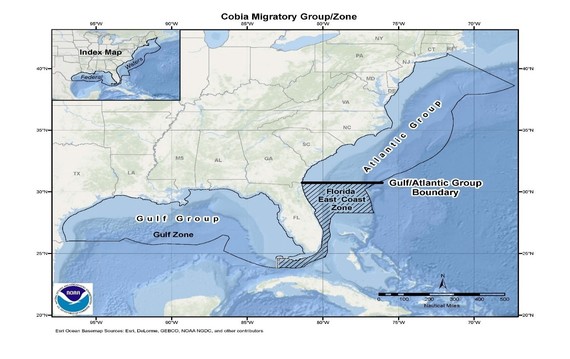|
KEY MESSAGE:
The final rule for Framework Amendment 7 to the Fishery Management Plan for Coastal Migratory Pelagic Resources in the Gulf of Mexico and Atlantic Region will increase the recreational and commercial minimum size limit for cobia in the Gulf Zone (see map) from 33 inches fork length to 36 inches fork length.

|
|
WHEN WILL THE RULE TAKE EFFECT:
The final rule will be effective on March 25, 2020.
This bulletin serves as a Small Entity Compliance Guide, complying with section 212 of the Small Business Regulatory Enforcement Fairness Act of 1996.
MORE INFORMATION:
If you have further questions regarding this matter, please contact the Southeast Regional Office Sustainable Fisheries Office at the address below or by telephone at (727) 824-5305, weekdays between 8:00 a.m. and 4:30 p.m.
The Environmental Assessment for the Framework Amendment 7 Final Rule may be found online at the NOAA Fisheries Southeast Regional Office Web site at: https://www.fisheries.noaa.gov/management-plan/gulf-mexico-and-south-atlantic-coastal-migratory-pelagic-fishery-management-plan.
|
|
|
Why did the Gulf of Mexico Fishery Management Council (Gulf Council) request the size reduction?
- At its meeting in April 2018, the Gulf Council explored options for reducing fishing mortality of Gulf cobia in the Gulf Zone based on public comments by stakeholders expressing concern regarding the condition of the stock and that recreational landings decreased in 2017 and 2018.
- The most recent stock assessment did not indicate that Gulf cobia are overfished (population is too low) or undergoing overfishing (fishing mortality is too high). The next stock assessment is scheduled to be available in the fall of 2020.
- The Gulf Council decided to increase the commercial and recreational minimum size limit for Gulf cobia as a precautionary approach, in case the decrease in landings indicates some presently unknown issue with the stock.
Why is the minimum size limit only changing in the Gulf?
- The South Atlantic Fishery Management Council was informed of the proposed changes to the minimum size limit for the Gulf zone and chose not to consider changes for the Florida East Coast zone at this time.
- Atlantic cobia, which range from the Georgia-Florida state line north to New York, can reach similar sizes as Gulf cobia, but do so over a longer lifespan. Therefore, the management measures appropriate for Atlantic cobia may not be appropriate for Gulf cobia.
Why did the Gulf Council decide not to change the possession limit?
- The Gulf Council determined that a reduction in the Gulf cobia possession limit to one fish would have minimal benefit to the stock given that most trips (greater than 95 percent) do not catch more than one cobia per person.
Where can I find more information on Framework Amendment 7?
- Contact NOAA Fisheries, Southeast Regional Office
By Mail: Rich Malinowski
NOAA Fisheries, Southeast Regional Office
Sustainable Fisheries Division
263 13th Avenue South
St. Petersburg, Florida 33701-5505
By FAX: (727) 824-5308 By Phone: (727) 824-5305
|
|
Sign Up for Text Message Alerts
NOAA's Text Message Alert Program allows you to receive important fishery related alerts via text message (SMS). Standard message and data rates may apply. You may opt-out at any time. Text alerts you may receive include immediate fishery openings and closures and any significant changes to fishing regulations that happen quickly.
Sign up for one or more of the fisheries-related alerts below by texting the following to 888777:
- Gulf of Mexico Recreational: Text GULFRECFISH
- Gulf of Mexico Commercial: Text GULFCOMMFISH
- South Atlantic Recreational: Text SATLRECFISH
- South Atlantic Commercial: Text SATLCOMMFISH
- Caribbean: Text CARIBFISH
|
|
Other Contacts
Media: Kim Amendola (727) 551-5705, Allison Garrett (727) 551-5750
|
|
|
|